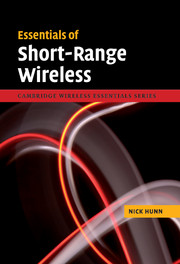Book contents
- Frontmatter
- Contents
- 1 Introduction
- 2 Fundamentals of short-range wireless
- 3 Wireless security
- 4 Bluetooth
- 5 IEEE 802.11abgn/Wi-Fi
- 6 IEEE 802.15.4, ZigBee PRO, RF4CE, 6LoWPAN and WirelessHART
- 7 Bluetooth low energy (formerly Wibree)
- 8 Application development – configuration
- 9 Application development – performance
- 10 Practical considerations – production, certification and IP
- 11 Implementation choices
- 12 Markets and applications
- Glossary of acronyms and abbreviations
- Index
- References
6 - IEEE 802.15.4, ZigBee PRO, RF4CE, 6LoWPAN and WirelessHART
Published online by Cambridge University Press: 10 November 2010
- Frontmatter
- Contents
- 1 Introduction
- 2 Fundamentals of short-range wireless
- 3 Wireless security
- 4 Bluetooth
- 5 IEEE 802.11abgn/Wi-Fi
- 6 IEEE 802.15.4, ZigBee PRO, RF4CE, 6LoWPAN and WirelessHART
- 7 Bluetooth low energy (formerly Wibree)
- 8 Application development – configuration
- 9 Application development – performance
- 10 Practical considerations – production, certification and IP
- 11 Implementation choices
- 12 Markets and applications
- Glossary of acronyms and abbreviations
- Index
- References
Summary
802.15.4 and ZigBee have become largely synonymous in the minds of many people. That's in large part a result of an excellent marketing campaign by the ZigBee Alliance. In fact, the two are used together to form ZigBee products; IEEE 802.15.4 defines a low-power radio and media access controller (MAC) and the ZigBee Alliance defines a mesh networking stack that sits on top of the 802.15.4 standard.
Although by far the best-known higher-layer protocol stack using the 802.15.4 radio, ZigBee is by no means the only one. There are at least a dozen other standards making use of this low-power radio, of which those with the largest market usage are probably RF4CE, WirelessHART and 6LoWPAN. In this chapter, I'll concentrate on the underlying 802.15.4 standard and ZigBee – in particular the ZigBee PRO standard, but I'll also provide a brief overview of these other three upcoming specifications.
One of the reasons that the 802.15.4 radio is so well known is that there are no licence fees or restrictions around using it. That has made it a favourite for universities and companies developing a myriad of different low-power sensor networks. There is an associated risk, in that there is no guarantee that using it does not infringe patents, but its relative simplicity and the availability of chips and development kits from a number of different suppliers means that it is likely to remain a popular choice.
- Type
- Chapter
- Information
- Essentials of Short-Range Wireless , pp. 147 - 175Publisher: Cambridge University PressPrint publication year: 2010

